1. Battery Testers
ZTS makes a line of very useful and accurate battery testers. They work well with a variety of batteries, including the alkaline and NiMH rechargeables used in most flashes.
If you use a lot of batteries, say for heavy flash use, a reliable battery tester is invaluable. For my multiple flash hummingbird photography workshops, we often go through several sets of AA batteries in a day. These can be rechargeable Nickel Metal Hydride (NiMH), alkaline, or lithium batteries. It pays to have a quick method of determining how much charge is left in each battery.
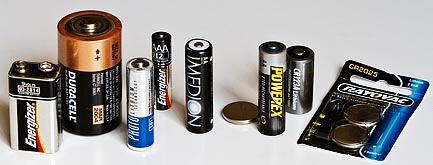
Figure 1. Some of the batteries you can test with the ZTS Battery Tester MBT-1.
See Table 2 for a complete list of compatible batteries.
I make heavy use of rechargeable NiMH batteries. But charge these batteries and let them sit on the shelf, and over several days many will slowly lose their charge. Again, a good battery tester will quickly tell you how fresh the charge is in each battery.
You may have many photo accessories that use a variety of retail batteries. And batteries are ubiquitous in our lives—think of all those remote controls in your living room, and flashlights in your drawers.
I have found the "Pulse Load" Battery Testers from ZTS, Inc. to be very useful and versatile. There are large models for your workbench, and smaller models you can stuff in your camera bag. Each one will test a variety of battery models, clearly marked on the tester.
2. Microprocessor-Controlled "Pulse Load" Technology
The simplest battery testers (which are virtually worthless) simply measure voltage; but voltage alone is a very poor measure of remaining battery life.
ZTS testers incorporate a microprocessor that utilizes the company's patented "Pulse Load" measurement technology. A "load" refers to a current drain that is applied to the battery—actually using it to power something, which draws current from the battery, and affects the voltage. To accurately assess the state of a battery, you need to measure the current and voltage under controlled loads. Then, armed with a knowledge of the current-voltage characteristics for that battery type—and perhaps a degree in electrical engineering for good measure—you can determine the remaining life of the battery.
The ZTS microprocessor "brain" does all this for you, and it knows how different battery types respond to the test. The "Pulse Load" means the tester applies the load in very brief pulses, so as to not excessively drain the battery, but provide an accurate measurement. It all takes only a few seconds for each battery, and then a simple graphical LED display flashes to show you the percent of power remaining. Now you know whether to use, recharge, or replace that battery.
ZTS has several models which can serve your needs. I keep the large MBT-1 at home, and take the compact (but less versatile) Mini-MBT with me on trips.
(Note that these testers won't work with the proprietary Lithium ion batteries that power most digital cameras; but generally your camera will have an accurate display of remaining power.)
3. ZTS Tester Models
ZTS Multi-Battery Tester (MBT-1)
The MBT-1 (Figure 2) can test a wide range of batteries (see Table 2). It's powered by four AA batteries. It's always on, but goes to sleep when not in use (the batteries should last two years with normal use). It's very simple to use (it takes longer to describe than to actually use).
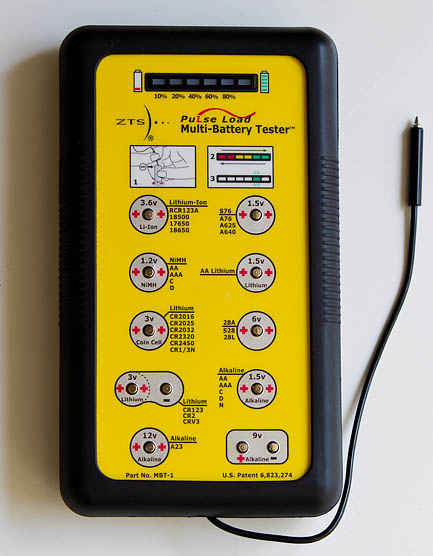
Figure 2. ZTS Battery Tester MBT-1.
There are ten positions corresponding to different battery types. You hold the positive tab of your battery at the appropriate location, and contact the negative tab with the attached probe to begin the test. After a few seconds the graphical display at the top lights up with your result.
There are no switches or settings. The top of the unit has ten locations that are clearly marked for various battery types. Simply hold the positive terminal of the battery against the appropriate tab, then hold the attached probe against the back terminal of the battery. After a few seconds (while holding the battery in place), the LED display will flash to show various power levels (10%, 20%, 40%, 60%, 80%, 100%). If you did this correctly and no LEDs light up, the battery is completely drained.
The MBT-1 works equally well for alkaline and rechargeable batteries (AA, AAA, C, and D), which are probably the ones most used. The current model MBT-1 adds the ability to test AA and AAA lithium batteries, a feature that was sorely lacking in the previous, discontinued model. The other battery types are less common, but I'll frequently encounter some photo gear or household gadget that uses one of them, and it's nice to be able to test them.
ZTS Mini Multi-Battery Tester (MINI-MBT)
The MINI-MBT is significantly smaller than the MBT-1. The trade-off is a limited array of batteries it can test. But it can test the commonly used AA, AAA, C, D alkaline and rechargeable NiMH and NiCd batteries (as well as 3v lithium cylindrical, and 9v alkaline and carbon zinc batteries; see Table 2).
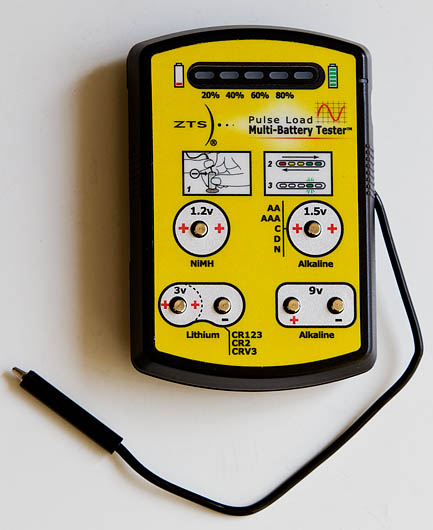
Figure 3. ZTS Battery Tester MINI-MBT.
This smaller tester has four battery positions, and is ideal for travel (assuming it tests the types of batteries you use; see Table 2). Operation is similar to the MBT-1.
When powering my flashes I'm constantly testing alkaline and NiMH rechargeable AA batteries in the field with this compact tester. (I wish it could test Lithium AA batteries, but in practice I rarely use those now, preferring the more economical NiMH rechargeables.)
The MINI-MBT is powered by four AAA batteries. Operation is similar to the MBT-1, except there is a push button switch to turn the unit on; it automatically shuts down if unused for two minutes.
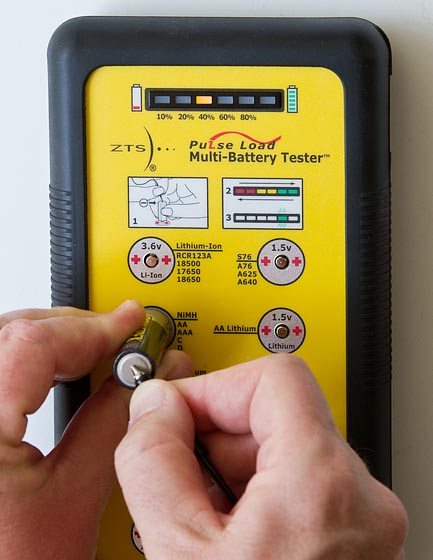
Figure 4. Testing a AA NiMH battery.
The light at the top of the tester indicates this battery has 40% charge remaining.
ZTS Mini 9R Multi-Battery Tester (MINI-MBT9R )
The MINI-MBT9R is a slight variation on the MINI-MBT, adding the ability to test 9 volt rechargeable NiMH batteries instead of 3 volt photo lithium batteries. I'm not aware of photo gear that uses those 9 volt batteries, but if you use them then this might be the tester for you.
ZTS lead acid Multi-Battery Tester (MBT-LA2)
This large and heavy ZTS model is dedicated to testing lead-acid batteries. I doubt it's useful to most photographers, but I include it for completeness.
Testing capability:
- 2-volt (2-25AH)
- 4-volt (2-25AH)
- 6-volt (1-4AH, 5-15AH, 16-50AH, 51-200AH)
- 8-volt (2-20AH, 21-150AH)
- 12-volt (1-4AH, 5-15AH, 16-50AH, 51-200AH)
4. Specifications
Table 1. ZTS battery testers
| ZTS model |
Size, inches
|
Weight
|
Price |
Optional
Padded Case |
| MBT-1 |
8 x 4.5 x 1.25 |
14.5 oz. / 400g |
$75 |
SC-MBT1 $8.47 |
| MINI-MBT |
4 x 2.5 x 0.75 |
3 oz. / 85g |
$30 |
SC-MINI $3.41 |
| MINI-MBT9R |
4 x 2.5 x 0.75 |
3 oz. / 85g |
$30 |
SC-MINI $3.41 |
| MBT-LA2 |
9.25 x 6.25 x 2 |
32 oz. /908g |
$350 |
included |
Table 2. Battery types compatible with ZTS testers
| Battery type |
Battery models |
MBT-1 |
MINI-MBT |
MINI-MBT9R |
MBT-LA2 |
| 1.2v NiMH/NiCd rechargeable |
AA, AAA, C, D |
 |
 |
 |
|
| 1.5v alkaline |
AA, AAA, C, D |
 |
 |
 |
|
| 9v alkaline & carbon zinc |
|
 |
 |
 |
|
| 9v NiMH rechargeable |
|
|
|
 |
|
| 3v lithium cylindrical |
CR123, CR2, CRV3 |
 |
 |
|
|
| 1.5v lithium |
AA L91, AAA L92 |
 |
|
|
|
| 3v lithium coin |
CR1616, CR1620, CR2016, CR2025, CR2320, CR2032, CR2430, CR2450, 58L, 1/3N |
 |
|
|
|
| 3.6v Li-Ion rechargeable |
RCR123A, 18500, 17650, 18650 |
 |
|
|
|
| 1.5v button cell |
S76, A76, A625, A640, LR44, 357, 303 |
 |
|
|
|
| 6v '28' series |
28A, S28, 28L, 544, 4LR44 |
 |
|
|
|
| 12v alkaline |
A23 |
 |
|
|
|
| Lead acid |
2v - 12v models |
|
|
|
 |
5. Some Tips for Using ZTS Testers
You need to make firm contact to both terminals of the battery and hold it for several seconds, until the readout flashes and then stops. If a contact slips off, wait a few seconds and try again. It's easy with a little practice.
Make sure the contacts on the battery and tester are clean.
Used batteries may "recover" when rested. For best accuracy, always make two or more consecutive tests to verify that the battery has stabilized, waiting a few seconds between each test.
If you're traveling with one of these testers, the optional padded case offers some protection (see Table 1).
The MBT-1 is a frequently used tool on my workbench at home, for everything from my flash batteries to diagnosing a faulty TV remote or testing the lithium coin cells that power my cycling computer. And the compact MINI-MBT accompanies me on all trips where I use flash, to ensure my AA flash batteries are fully charged and ready to use. I wouldn't want to be without them.
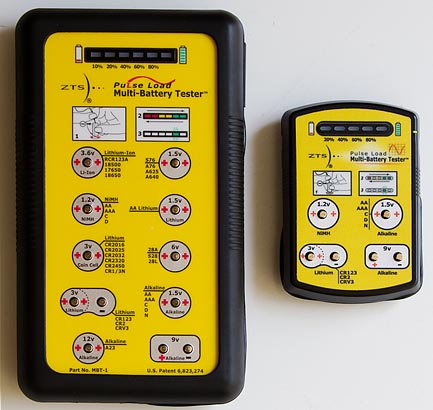
Figure 5. The ZTS MBT-1 and MINI-MBT side by side.
The probe cords stow into slots on the sides of the units.